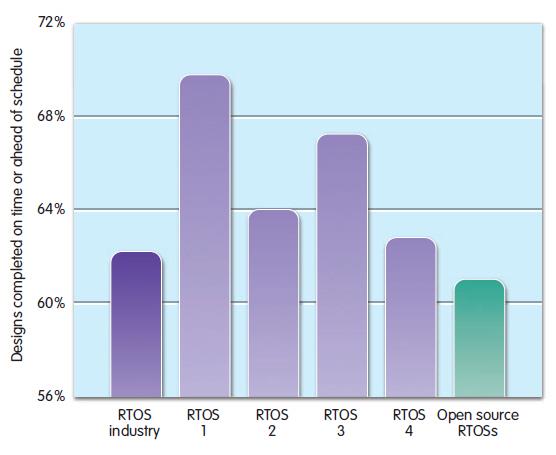Years ago, such products were less common and often ill-fated, as the electronics industry tinkered with free or low-cost, open-source, or do-it-yourself RTOSs. The results saw unreliable products, overdue development schedules and costly staffing levels as the industry struggled with unproven software. Today, commercial RTOSs dominate devices such as cameras, wearables, home security systems, televisions, flight control systems and medical products.
These RTOSs – which can be described as ‘industrial-grade’ – are at the high end of the commercial RTOS spectrum. Offerings in this sector can vary significantly in the features, performance and robustness offered. However, choosing this high-end software can also have a dramatic impact on time to market, which is a critical success factor for today’s hottest technology products.
The importance of time to market
The characteristics offered by industrial RTOSs provide one overarching benefit – they enable software projects to be completed on time. While the cost savings of finishing a project on schedule should be evident, a far greater impact to profitability is seen on the revenue side. Being late with a product reduces the addressable market for a product significantly.
Figure 1 (below) illustrates the effect of time to market on aggregate sales volume by showing a product-adoption curve over time. The green and orange areas beneath the curve represent the total number of product units that can be sold. Being late erodes the market (green portion) in two ways. First, you don’t get to sell the product for as long as you might have been able to. Second, you lose market share early and can’t regain it later, so the number of available prospects is smaller. The result is lost revenue compared to what would have been possible with an earlier product introduction.

What can developers do to help bring better products to market more quickly? Design teams are in control of one critical aspect of time to market – and that is completing their development project on time. For projects that feaure an RTOS, research shows the impact that RTOS selection has on time to market.
Industry analysts at Embedded Market Forecasters (EMF)surveyed more than 500 embedded systems developers for the past several years. Their research has found that commercial RTOSs dominate return on investment (ROI) results, compared with open source RTOSs, when it comes to development time.
In a white paper entitled ‘Shoot-Out at the RTOS Corral’, EMF outlined what it saw as the ROI advantages of using commercial RTOSs over others. According to the survey, commercial RTOSs better enable developers to meet schedules and to get products to market on time, with 60% of projects completed ‘on time or ahead of schedule’.
Furthermore, specific commercial RTOSs fared better than others. A tabulation of recent (2016) data in a recent EMF white paper – Comparing time to market of open source software with time to market of commercial RTOSes – revealed that, on average, 38% of projects were completed behind schedule. Projects that used an industrial-grade RTOS – such as Express Logic’s ThreadX RTOS – performed the best, with 70% of those projects completed on schedule or even early (see fig 2). Clearly, using the right RTOS can significantly benefit a project’s likelihood of finishing on time.

Ensuring product quality
Of course, getting to market quickly is meaningless unless you deliver a quality, reliable product that hits performance targets with the full set of features demanded by the market. Development teams always make trade-offs among factors including features, performance, development time, and budget. It’s tempting to spend as little as possible for development, but that can be penny wise and pound foolish. Using the best tools, including RTOS, compiler and other development tools, might cost more than using free or less costly alternatives, but the data shows that the nominal savings typically represents only a fraction of the resulting cost of being late to market or delivering a product with noncompetitive performance or quality.
Developers who achieve fast schedule completion by jettisoning product performance, functionality or features jeopardise product success. Again, in this area, an industrial-grade RTOS shows better results than the industry average (see table 1, below).
| Within 10% for: | RTOS industry | RTOS 1 | RTOS 2 | RTOS 3 | RTOS 4 | Open source |
| Performance | 46% | 68.4% | 49.7% | 62.8% | 45.7% | 52.7% |
| Systems functionality | 45% | 57.9% | 37.6% | 70.8% | 52.9% | 48.5% |
Conclusion
The decision regarding where to spend your limited development budget – and, indeed, how large a development budget you need – must be made in the context of the overall success of the product and the enterprise. Choosing an industrial-grade RTOS – the highest standard of commercial software available – enables fast time-to-market and high performance as well as additional powerful benefits to developers.
Author profile:
Michael May is vice president of marketing with Express Logic.
What is ‘industrial grade’? Industrial-grade real-time operating systems have these characteristics:
|













